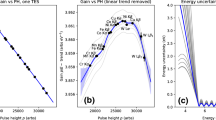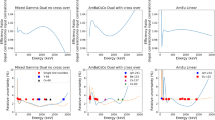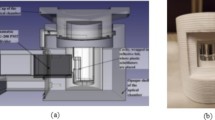Abstract
The scintillator detectors are recalibrated against the datasheet given by the manufacturer. Optimal and mutual dependent values of (a) high voltage at PMT (Photomultiplier Tube), (b) amplifier gain, (c) average time to count the radiation particles (set by operator), and (d) number of instances/sample number are estimated. Total 5: two versions of Central Limit Theorem (CLT), (3) industry preferred Pulse Width Saturation, (4) calibration based on MPPC coupled Gamma-ray detector, and (5) gross method are used. It is shown that the CLT method is the most optimal method to calibrate the detector and its respective electronics couple. An inverse modeling-based Computerized Tomography method is used for verification. It is shown that statistically averaging results are more accurate and precise data than mode and median if the data is not skewed and a random number of samples are used during the calibration process. It is also shown that the average time to count the radiation particle is the most important parameter affecting the optimal calibration setting for precision and accurate measurements of gamma radiation.








Similar content being viewed by others
References
Baccouche, S., Al-Azmi, D., Karunakara, N., & Trabelsi, A. (2012). Application of the Monte Carlo method for the efficiency calibration of CsI and NaI detectors for gamma-ray measurements from terrestrial samples. Applied Radiation and Isotopes, 70(1), 227–232.
Cuesta, C., Oliván, M. A., Amaré, J., Cebrián, S., García, E., Ginestra, C., & Pobes, C. (2013). Slow scintillation time constants in NaI (Tl) for different interacting particles. Optical Materials, 36(2), 316–320.
Chuong, H. D., Hung, N. Q., Le, N. T. M., Nguyen, V. H., & Thanh, T. T. (2019). Validation of gamma scanning method for optimizing NaI (Tl) detector model in Monte Carlo simulation. Applied Radiation and Isotopes, 149, 1–8.
Freitas, E. D. C., Fernandes, L. M. P., Yahlali, N., Pérez, J., Álvarez, V., Borges, F. I. G., & Monteiro, C. M. B. (2015). PMT calibration of a scintillation detector using primary scintillation. Journal of Instrumentation, 10(02), C02039–C02039. https://doi.org/10.1088/1748-0221/10/02/c02039
Beylin, D. M., Korchagin, A. I., Kuzmin, A. S., Kurdadze, L. M., Oreshkin, S. B., Petrov, S. E., & Shwartz, B. A. (2005). Study of the radiation hardness of CsI(Tl) scintillation crystals. Nuclear Instruments and Methods in Physics Research Section A: Accelerators, Spectrometers, Detectors and Associated Equipment, 541(3), 501–515. https://doi.org/10.1016/j.nima.2004.11.023.
Grinev, B. V., Nikulina, R. A., Bershinina, S. P., & Vinograd, É. L. (1991). Investigation of the aging of scintillation detectors. Soviet Atomic Energy, 70(1), 66–68. https://doi.org/10.1007/BF01129991
Cabrera, S., Cauz, D., Dreossi, D., Ebina, K., Iori, M., Incagli, M., … Yorita, K. (2000). Making the most of aging scintillator. Nuclear Instruments and Methods in Physics Research Section A: Accelerators, Spectrometers, Detectors and Associated Equipment, 453(1), 245–248. https://doi.org/10.1016/S0168-9002(00)00640-9.
Derenzo, S. E., Choong, W.-S., & Moses, W. W. (2014). Fundamental limits of scintillation detector timing precision. Physics in medicine and biology, 59(13), 3261–3286. https://doi.org/10.1088/0031-9155/59/13/3261
Prekeges, J. L. (2014). Sweating the small stuff: Pitfalls in the use of radiation detection instruments. Journal of nuclear medicine technology, 42(2), 81–91. https://doi.org/10.2967/jnmt.113.133173
Prekeges, J. (2012). Nuclear Medicine Instrumentation (book). Jones & Bartlett Publishers.
Rousselet, G. A., & Wilcox, R. R. (2020). Reaction times and other skewed distributions: problems with the mean and the median. Meta-Psychology, 4. https://doi.org/10.15626/MP.2019.1630
Holt, M. M., & Scariano, S. M. (2009). Mean, Median and Mode from a Decision Perspective. Journal of Statistics Education, 17(3), null. https://doi.org/10.1080/10691898.2009.11889533.
HOCHBERG, Y. (1988). A sharper Bonferroni procedure for multiple tests of significance. Biometrika, 75(4), 800–802. https://doi.org/10.1093/biomet/75.4.800
Albers, C., & Lakens, D. (2018). When power analyses based on pilot data are biased: Inaccurate effect size estimators and follow-up bias. Journal of Experimental Social Psychology, 74, 187–195. https://doi.org/10.1016/j.jesp.2017.09.004.
Forstmeier, W., Wagenmakers, E.-J., & Parker, T. H. (2017). Detecting and avoiding likely false-positive findings – a practical guide. Biological Reviews, 92(4), 1941–1968. https://doi.org/10.1111/brv.12315.
Colquhoun, D. (2014). An investigation of the false discovery rate and the misinterpretation of p-values. Royal Society Open Science, 1(3), 140216. https://doi.org/10.1098/rsos.140216
Button, K. S., Ioannidis, J. P. A., Mokrysz, C., Nosek, B. A., Flint, J., Robinson, E. S. J., & Munafò, M. R. (2013). Power failure: Why small sample size undermines the reliability of neuroscience. Nature Reviews Neuroscience, 14(5), 365–376. https://doi.org/10.1038/nrn3475
Tsoulfanidis. (2010). Measurement and Detection of Radiation. Measurement and Detection of Radiation (Third.). CRC Press. https://doi.org/10.1201/9781439894651.
Almutairi, B., Akyurek, T., & Usman, S. (2019). Voltage dependent pulse shape analysis of Geiger-Müller counter. Nuclear Engineering and Technology, 51(4), 1081–1090.
Wang, W. H. (2003). The operational characteristics of a sodium iodide scintillation counting system as a single-channel analyzer. Radiation protection management, 20(5), 28–36.
Method for Accurate Energy Calibration of Gamma Radiation Detectors with only Count Rate Data. (Conference) | OSTI.GOV. (n.d.). Retrieved April 2, 2021, from https://www.osti.gov/biblio/1571194.
Kumar, A., Shakya, S., & Goswami, M. (2020). Optimal frequency combination estimation for accurate ultrasound non-destructive testing. Electronics Letters, 56(19), 1022–1024.
Tsoulfanidis, N. (2010). Measurement and detection of radiation. CRC Press.
Trotter, H. F. (1959). An elementary proof of the central limit theorem. Archiv der Mathematik, 10(1), 226–234.
Brosamler, G. A. (1988). An almost everywhere central limit theorem. In Mathematical Proceedings of the Cambridge Philosophical Society (Vol. 104, pp. 561–574). Cambridge University Press.
Gauch, H. G., Jr., & Chase, G. B. (1974). Fitting the Gaussian curve to ecological data. Ecology, 55(6), 1377–1381.
Xu, W., Chen, W., & Liang, Y. (2018). Feasibility study on the least square method for fitting non-Gaussian noise data. Physica A: Statistical Mechanics and its Applications, 492, 1917–1930.
Zhang, B., Zerubia, J., & Olivo-Marin, J.-C. (2007). Gaussian approximations of fluorescence microscope point-spread function models. Applied optics, 46(10), 1819–1829.
Liu, H., Liu, W., Zhong, X., Liu, B., Guo, D., & Wang, X. (2016). Modeling of laser heat source considering light scattering during laser transmission welding. Materials & Design, 99, 83–92.
Guo, H. (2011). A simple algorithm for fitting a Gaussian function [DSP tips and tricks]. IEEE Signal Processing Magazine, 28(5), 134–137.
Al-Nahhal, I., Dobre, O. A., Basar, E., Moloney, C., & Ikki, S. (2019). A Fast, Accurate, and Separable Method for Fitting a Gaussian Function [Tips & Tricks]. IEEE Signal Processing Magazine, 36(6), 157–163.
Johnson, N. L., S. Kotz, and N. B. (n.d.). Continuous Univariate Distributions, Volume 2, 2nd Edition | Wiley (Second.).
Radiation detection module C12137 | Hamamatsu Photonics. (n.d.). Retrieved March 25, 2021, from https://www.hamamatsu.com/jp/en/product/type/C12137/index.html
Model PNS-2 Para Nuclear Spectrometer. (n.d.).
Goswami, M., Shakya, S., Saxena, A., & Munshi, P. (2016). Optimal Spatial Filtering Schemes and Compact Tomography Setups. Research in Nondestructive Evaluation, 27(2), 69–85. https://doi.org/10.1080/09349847.2015.1060659
Akyurek, T., Yousaf, M., Liu, X., & Usman, S. (2015). GM counter deadtime dependence on applied voltage, operating temperature and fatigue. Radiation Measurements, 73, 26–35. https://doi.org/10.1016/j.radmeas.2014.12.010.
Holland, P. W., & Welsch, R. E. (1977). Robust regression using iteratively reweighted least-squares. Communications in Statistics-theory and Methods, 6(9), 813–827.
Seber, G. A. F., & Wild, C. J. (2003). Non-linear regression. hoboken. New Jersey: John Wiley & Sons, 62, 63.
Dumouchel, W., & O’Brien, F. (1989). Integrating a robust option into a multiple regression computing environment. In Computer science and statistics: Proceedings of the 21st symposium on the interface (pp. 297–302). American Statistical Association Alexandria, VA.
Hinich, M. J., & Talwar, P. P. (1975). A Simple Method for Robust Regression. Journal of the American Statistical Association, 70(349), 113–119. https://doi.org/10.1080/01621459.1975.10480271
Peduzzi, P., Concato, J., Feinstein, A. R., & Holford, T. R. (1995). Importance of events per independent variable in proportional hazards regression analysis II. Accuracy and precision of regression estimates. Journal of clinical epidemiology, 48(12), 1503–1510.
Goswami, M., Shakya, S., Saxena, A., & Munshi, P. (2015). Reliable reconstruction strategy with higher grid resolution for limited data tomography. NDT and E International, 72. https://doi.org/10.1016/j.ndteint.2014.09.012.
Tianfeng C., & Draxler, R. R. (2014). “Root mean square error (RMSE) or mean absolute error (MAE)?–Arguments against avoiding RMSE in the literature.” Geoscientific Model Development, 7.3, 1247–1250.
Barron, A. R. (1986). “Entropy and the Central Limit Theorem.” Annals of Probability, 14(1), 336–342. https://doi.org/10.1214/aop/1176992632.
Acknowledgements
This work is partially supported by the Department of Science and Technology-Science and Engineering Research Board (DST-SERB) under Early Career scheme, Project number: ECR/2017/001432, Government of India and Office of Dean Finance & Planning, IIT Roorkee, Roorkee, India. We acknowledge Mr. Kumar Abinash Misra, DIC Intern from Dept. of Mechanical Engineering, IIT Mandi, for helping us to take initial data.
Author information
Authors and Affiliations
Contributions
Kajal has contributed to experiments, analysis, coding, and writing text. Mayank has designed the study, contributed to analysis, experiments, coding, writing text, and arranging funds for resources.
Corresponding author
Ethics declarations
Competing Interests
The authors declare that no competing interest exists.
Additional information
Publisher's Note
Springer Nature remains neutral with regard to jurisdictional claims in published maps and institutional affiliations.
Rights and permissions
About this article
Cite this article
Kumari, K., Goswami, M. Sensitivity Analysis of Calibration Methods and Factors Effecting the Statistical Nature of Radiation Measurement. J Sign Process Syst 94, 387–397 (2022). https://doi.org/10.1007/s11265-021-01685-9
Received:
Revised:
Accepted:
Published:
Issue Date:
DOI: https://doi.org/10.1007/s11265-021-01685-9




